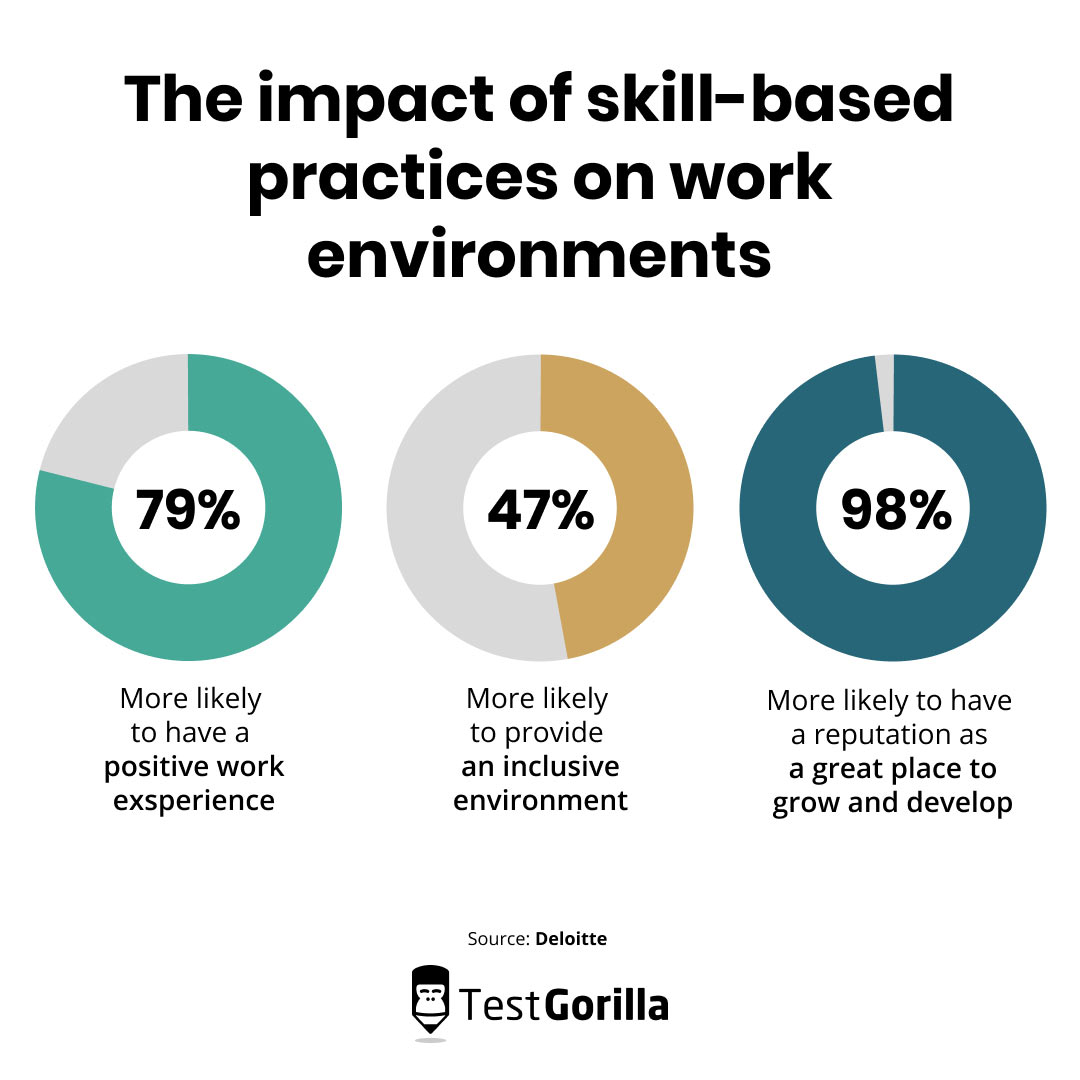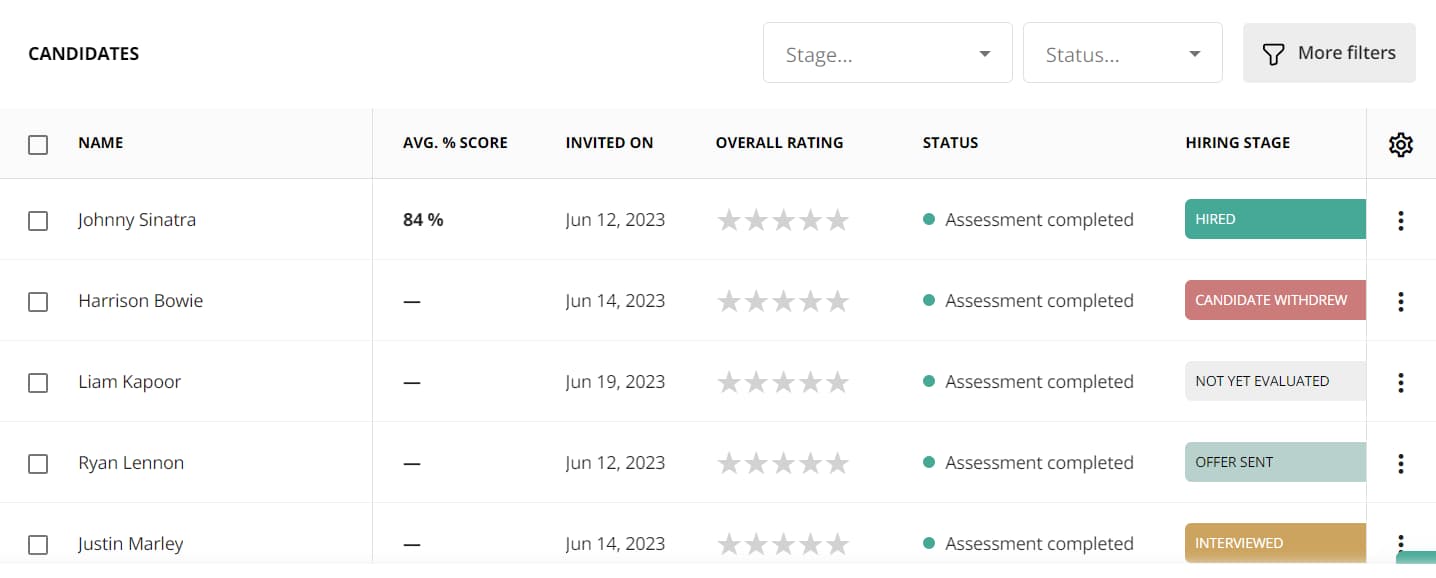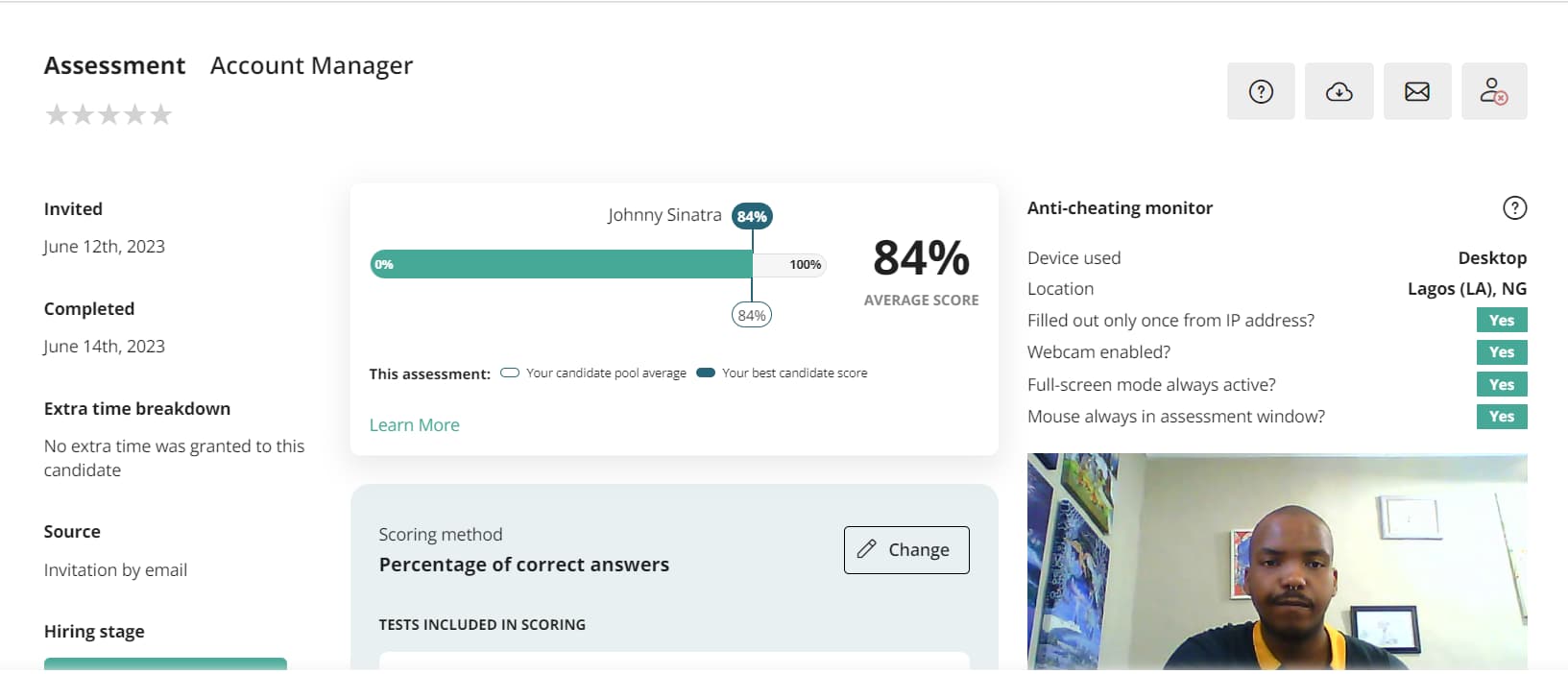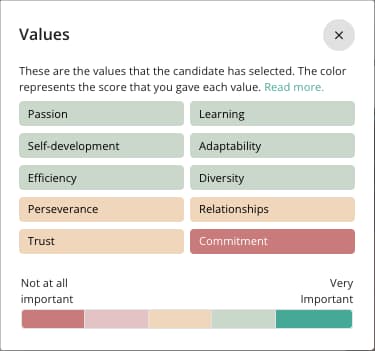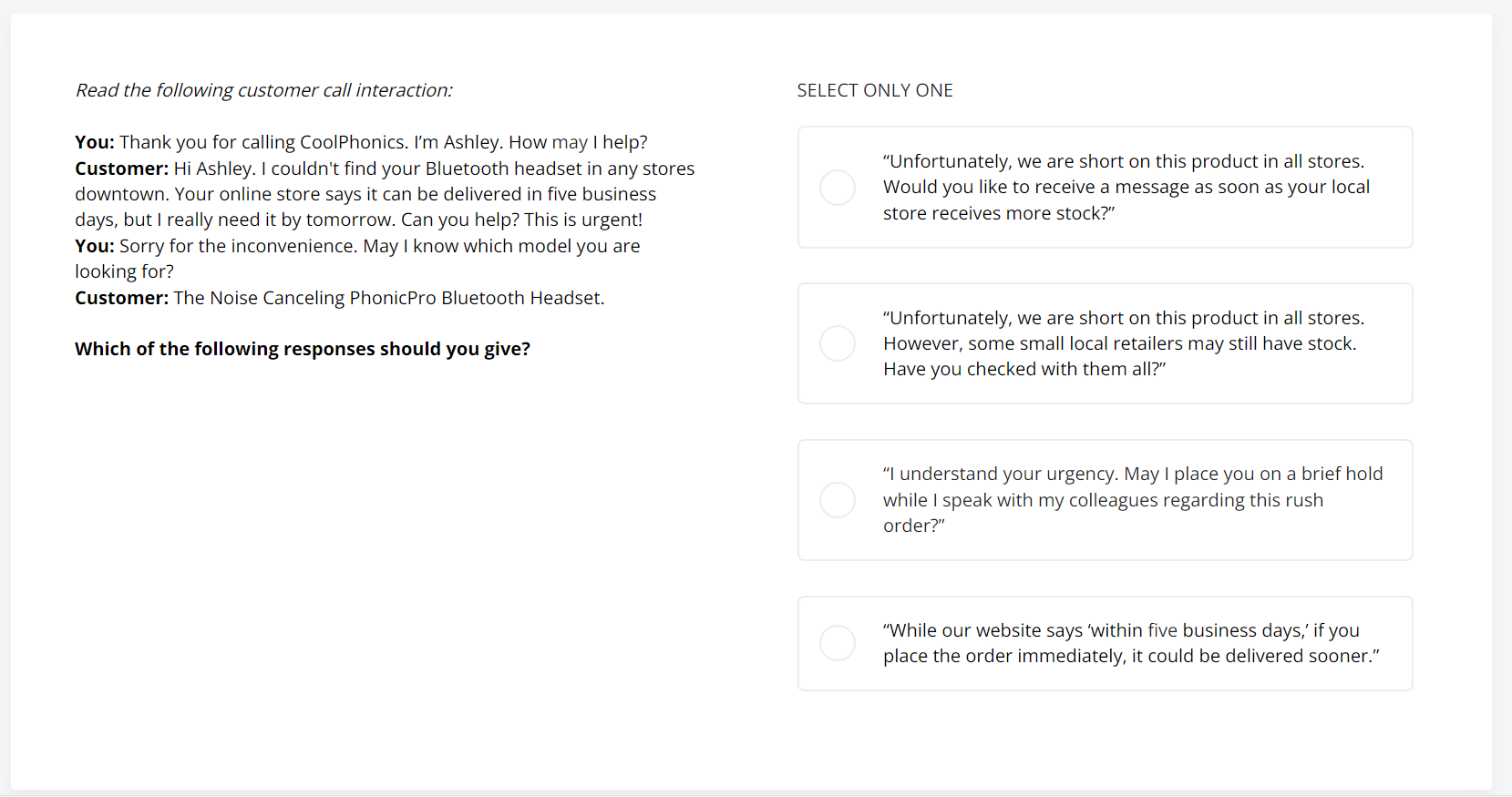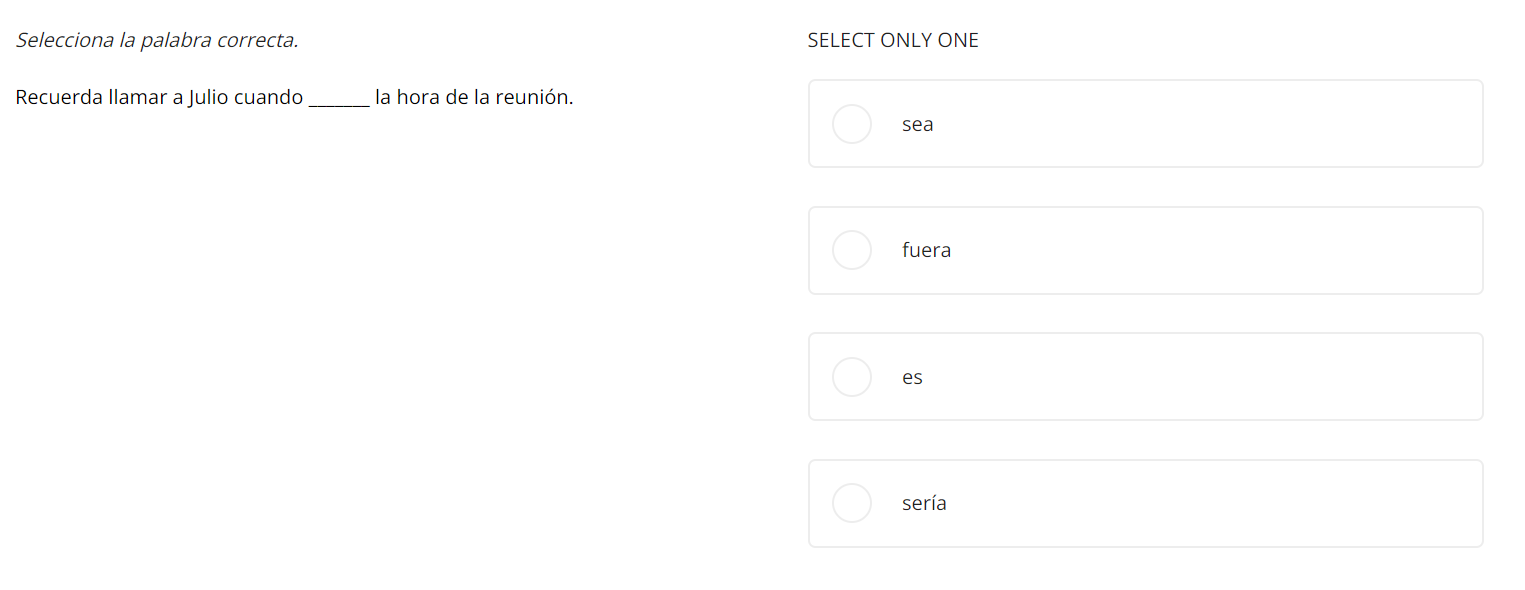Talent assessments for enterprises: Focusing on the right skills and culture add attributes for your organization
Major enterprises can have an impressive tech stack and an excellent HR team, but they still face frustrating hiring challenges.
The larger your company, the more likely it is that low-quality candidates get through the process.
One study found that 74% of employers say they’ve hired the wrong person for a position.[1]
When you’re juggling a high volume of candidates and can’t spend a lot of time vetting them, this occurrence is common.
Using talent assessments for enterprises helps you address this issue head-on, so you can find the best candidates quickly and efficiently and uphold crucial cultural values.
Talent assessments also match skills to job roles, improving performance and retention.
This article discusses the benefits of using talent assessments for large companies and the actionable best practices for getting the most out of them.
Table of contents
- What are talent assessments for enterprises?
- The benefits of talent assessments for large companies
- How to get the most out of talent assessments: 8 best practices for large enterprises
- 4 examples of enterprises succeeding in using talent assessments to streamline recruitment and reduce time-to-hire
- Find top talent in a sea of candidates with talent assessments for enterprises
What are talent assessments for enterprises?
Talent assessments for enterprises are skills-based hiring methods that large companies use to gauge candidate quality and assess and shortlist large volumes of applicants to ensure they have the right skills.
According to TestGorilla’s State of Skills-Based Hiring report, the influence of these assessments is on the rise:
91.9% of employers believe that skills-based hiring is more effective for identifying talented candidates than resumes
88.8% think that skills-based hiring is more predictive of on-job success than resumes
81.8% believe that employees hired via skills-based hiring stay longer in their roles
More than half of our respondents were large enterprises, but talent assessments are flexible and apply to any industry or company size.
Talent assessments for startups show that these tests are valuable even when hiring your first handful of workers.
The benefits of talent assessments for large companies
Talent assessments for corporations help hiring teams sort through thousands of applicants to find quality candidates, reducing mis-hires and enriching company culture.
They also remove the need to scan through countless resumes because you can shortlist the best with a few clicks.
Let’s examine these advantages and more.
Reduce mis-hires
Large companies struggle with mis-hires. When you have a massive turnout of applicants, it’s difficult to find the right candidates. Using talent assessments drastically reduces mis-hires.
Our report – mentioned above – found that 88% of organizations that used skills-based hiring in 2023 saw a reduction in mis-hires.
When you use data to gauge skills and competencies, you’re much more likely to find the ideal candidate.
Candidates also see what you need in a role and your top cultural values so they can understand the environment and expectations before week one.
This point benefits many different business sizes – for instance, talent assessments for SMEs help small to mid-size businesses reduce the number of people they hire just to fill seats.
Boost retention
When companies get larger, it becomes more difficult to maintain a healthy retention rate.
For example, Walmart is in the bottom 25% in its ability to retain employees, and only 50% of workers believe the company is doing what it can to retain them.
Talent assessments increase employee retention. Our 2023 report found that 89% of organizations that used skills-based hiring improved employee retention.
How does a hiring method boost retention so consistently? When you use objective data to match an employee to a role, it makes it much more likely that they stay with you for a longer time.
Talent assessments also help you build a healthy, inclusive workplace by increasing diversity and enabling you to hire for culture add rather than culture fit.
An inclusive culture is essential for employee retention and makes workers 5.4 times more likely to want to stay with their employer for a long time and 9.8 times more likely to look forward to going to work.
Provide a reliable way to track and monitor candidates
Juggling large volumes of candidates makes it tricky to track high-quality candidates as they move through the recruitment funnel.
Talent assessment software enables employers to monitor candidates with a candidate database. In this database, you can sort applicants by name, assessments, tests, and job roles, ensuring you never lose track of a great potential hire.
This database is also excellent for future hiring efforts – “silver medalist” candidates from previous hiring initiatives are great for passive recruiting.
Plus, a lot of talent assessment software integrates with other recruiting software, like candidate relationship management (CRM) software and applicant tracking systems. They give you even more insights into your recruitment funnel.
Nurture company culture
When hiring hundreds of candidates, it’s easier to lose sight of your culture than it is when you’re only hiring one or two people.
Talent assessments like the Culture Add test enable you to prioritize your core values on a mass scale and open the doors to new perspectives and diversity.
Moreover, skills-based organizations have a powerful impact on culture because you create an environment where people are valued for their skills more than their connections or tenure.
According to Deloitte, skills-based organizations are:
79% more likely to have a positive work experience
47% more likely to provide an inclusive environment
98% more likely to have a reputation as a great place to grow and develop
Talent assessments maintain your current culture and gradually shift it toward a positive one.
Remove the need to scan thousands of resumes
Large enterprises usually have an excellent recruitment tech stack, but unfortunately, it’s sometimes a company’s technical process that filters out top talent.
Scanning resumes is problematic. A report from Harvard Business School found that 88% of employers say that qualified high-skill candidates are filtered out of the process by company software because they don’t match the exact criteria established in the job description.
That number rises to 94% for middle-skilled workers. This issue can also arise if the applicant leaves out a few keywords that your ATS is looking for.
When you use talent assessments, you eliminate the need for resumes.
These tests enable you to focus on skills and use a database that sorts candidates on quality, not keywords.
Promote diversity and inclusion
Diversity is a rising priority for businesses.
In 2023, 85% of employers said diversity is an objective, compared with 77% in 2022.
Enterprises can struggle with diversity. For example, Apple’s diversity report in 2014 showed its workforce was 70% male and 30% female. In 2022, the numbers shifted to 65.2% male and 34.8% female.
Although it’s an increase, it’s only a five percent increase in eight years.
Large companies rely heavily on traditional diversity and inclusion methods, like DE&I targets. These aren’t always effective and may even promote tokenism.
Talent assessments give you a natural way to increase inclusion without relying on diversity targets. Our data shows that 84% of companies using skills-based hiring report that it has a positive impact on diversity.
Skills-based hiring reduces unconscious bias, which is a major obstacle to diversity. It also reduces reliance on degree requirements, which can automatically screen out members of certain marginalized groups.
The best insights on HR and recruitment, delivered to your inbox.
Biweekly updates. No spam. Unsubscribe any time.
How to get the most out of talent assessments: 8 best practices for large enterprises
Talent assessments for large companies can serve many purposes, including monitoring great candidates, gauging company culture, and assessing language proficiency for international recruiting.
Here are our top tactics for getting the most out of your talent assessments.
Strategies for using talent assessments for large companies: A summary
Strategies | Description |
Use talent assessments to manage high volumes of candidates | |
1. Maintain the quality of your hiring process | Recruit quality candidates and maintain hiring consistency |
2. Discover the best candidates, and don’t let them slip away | Easily find top talent and monitor them through the recruitment process with a candidate database |
3. Weave assessments into your greater tech stack | Integrate talent assessments with other recruitment software to streamline hiring |
Take advantage of talent assessments to maintain a strong, healthy culture | |
4. Evaluate culture add and help uphold values | Test for culture add to maintain your values and bring in bright, new perspectives |
5. Boost retention by matching skills to the role | Ensure candidates have the skills they need for success |
6. Increase diversity naturally by removing unnecessary requirements | Reduce reliance on resumes and drop college degree requirements to increase your diversity |
Let talent assessments gauge hard-to-assess skills | |
7. Easily assess language proficiency in multinational companies | Effectively gauge language proficiency by using automated, data-driven language tests |
8. Screen niche roles with no niche expertise | Find niche professionals by testing for niche skills and relevant, complementary skills |
Use talent assessments to manage high volumes of candidates
First, we’re going to take a look at how talent assessments help you handle large volumes of applicants.
1. Maintain the quality of your hiring process
Large companies can get swept up in fast processes with too many moving parts, and as a result, the hiring process can suffer.
Talent assessments help inform and assist your high-volume hiring efforts without loss of quality and candidate experience:
Reduce mis-hires and focus on candidate skill and quality
Provide candidates with a personal, transparent experience
Improve consistency in the hiring process
Let’s quickly touch on that last point. Hiring the right people is easier when you create a foundational assessment with several key tests and then switch out role-specific skills for each unique position.
For instance, you can create a foundation with the Culture Add test, Time Management test, and Communication test, then add two role-specific skills tests per assessment.
Talent assessments help create a hiring process with consistent quality and maintain a quick time-to-hire and a low cost-per-hire.
2. Discover the best candidates, and don’t let them slip away
Large companies struggle with two major challenges regarding candidate quality:
Recruiting bad hires
Missing out on great candidates who slipped through the cracks
It’s easy to lose sight of candidates in any hiring process, but enterprises handle an enormous volume of applicants. For example, in 2022, L'Oreal received 1.3 million applications.[2]
This volume makes it incredibly hard to keep track of the best candidates – and incredibly easy for the wrong hire to get in.
Talent assessment tests ensure great candidates are recognized and only the best get through.
Here’s what TestGorilla’s system looks like:
You can quickly and easily sort candidates by test score so you only review top talent. Then, you can take a deeper look at each one for more detailed insights.
This database is essential to managing great candidates from the throngs of people who apply for your open roles. It also enables you to filter out unsuitable candidates based on skills rather than screening them out because of keywords on resumes.
3. Weave assessments into your greater tech stack
We know you already have a solid recruitment tech stack, and talent assessments can fit right in.
Talent assessment software integrates with other recruiting software and enhances it. It can integrate with applicant tracking systems (ATS), CRM software, and internal talent marketplaces.
For instance, you can access your candidate database from your CRM to keep track of the highest-scoring candidates as they move through the recruitment funnel.
Another example is being able to view assessment results through your ATS.
This strategy lets you take advantage of the benefits of talent assessments and smoothly work them into your current systems and processes.
Take advantage of talent assessments to maintain a strong, healthy culture
Here are our top strategies for maintaining and strengthening your company culture.
4. Evaluate culture add and help uphold values
Culture is difficult to maintain once your company has more than a few hundred employees, let alone thousands. It may lose priority somewhere along the way or become too difficult to manage at this scale.
You can make the process scalable and consistent by using talent assessments. Personality and culture tests are a fast, efficient way to gauge cultural alignment.
Specifically, our Culture Add test enables you to evaluate candidates based on culture add, not culture fit.
What’s the difference between culture add and culture fit? Culture fit hires people based on how similar they are to other team members, and culture add hires people who align with your core values but bring unique perspectives with them.
Our test takes information from a questionnaire you fill out and then evaluates candidates based on your answers.
Here’s what the results look like:
These results give you a clear, objective view of cultural alignment to make a fair decision. It turns the question from “Can I get drinks with this person after work?” to “Does this person value adaptability and efficiency?”
5. Boost retention by matching skills to the role
Because high-volume hiring can reduce the quality of the hires, retention is a key issue for enterprises.
Retention is a tough subject for many large companies. For example, Popeyes Louisiana Kitchen Inc. and Coinbase scored the lowest in a study about employee retention, having an average tenure of 0.8 years.[3]
When you hire employees in a hurry, it can create a temporary workforce that isn’t interested in staying for the long haul.
It happens because traditional recruitment methods can’t accurately determine if workers have the right skill set to help them confidently do their work.
Using talent assessments aligns a person’s skills with the job role, increasing satisfaction, confidence, and performance.
Let’s say you’re hiring for a customer service position, which has notoriously high turnover rates.[4]
You can use an assessment, including our Customer Service test, to ensure they have the right communication and empathy skills.
Talent assessments also help give candidates more accurate expectations of the role.
Applicants know when taking tests what kind of work and culture to expect, enabling them to make an informed decision about whether or not they want a job at your company.
6. Increase diversity naturally by removing unnecessary requirements
Using talent assessments lets you drop unnecessary requirements like college degrees and stop using resumes to inform you of candidate quality.
These hiring methods stifle true inclusion, so getting rid of them naturally increases diversity in the workplace.
For example, four-year degree requirements automatically screen out 76% of Black and 83% of Hispanic candidates.[5]
Resumes are problematic and introduce much unconscious bias into the hiring process.
There’s a lot of evidence that feminine-sounding names on resumes get a lower response rate, such as Erin McKelvey, who changed her name to “Mack McKelvey” on her resume and got a 70% response rate after repeated disappointment.[6]
Erin’s case isn’t the only one. This situation is unfortunately common and happens in many industries.
These traditional hiring methods only exist because we want an effective way to gauge candidate quality.
If you evaluate applicants by their raw skills using talent assessments, you can drop these outdated methods and find more diverse candidates.
Let talent assessments gauge hard-to-assess skills
Let’s wrap up our strategies with a few ways to evaluate skills that are tough to assess.
7. Easily assess language proficiency in multinational companies
Assessing language proficiency can be tricky for multinational companies with international branches. You have to assess candidates on a massive scale and still maintain accuracy.
Your hires may not have the proficiency you need, leading to miscommunication. It could also end in rejecting a hire, even though they were at the right level of proficiency.
Talent assessments for multinational companies enable you to accurately gauge language proficiency quickly and efficiently. Let’s use our Spanish (Proficient/C2) test as an example:
These talent assessments come in various languages and proficiency levels, so you can choose upper-intermediate tests for roles that require more demanding conversations.
After the assessment, you receive results immediately with no tedious, manual work like digging through handwritten language tests. Using language assessments like these enabled Revolut to almost cut its time-to-hire by half, but we discuss this company more below.
8. Screen niche roles with no niche expertise
Large companies may need to secure niche professionals in larger volumes than smaller businesses. This situation also applies to highly technical roles like cybersecurity and blockchain.
You may be able to hire one or two subject matter experts to help you find the right people, but certainly not for every role.
Talent assessments help you confidently test for tricky, niche skills.
These assessments help you measure the skills and evaluate relevant competencies, such as candidate potential. Potential is important when many niche skills are at risk of becoming obsolete.
You can also search for related skills that complement and assist niche skills. Here are a few complementary tests for a Cyber Security Analyst:
Evaluating candidates on a broad range of related skills helps you get a big-picture view of the candidate. For more information on this topic, read our article on the holistic hiring process.
4 examples of enterprises succeeding in using talent assessments to streamline recruitment and reduce time-to-hire
Now, let’s look at four large companies succeeding with skills-based hiring.
These businesses streamlined their processes, improved performance, and improved hiring speed by using talent assessments for corporations.
Large enterprises using talent assessments: A summary
Company | Why it’s successful |
DocuSign | Maintained quality during accelerated hiring |
Amazon | Assessed hard and soft skills in a wide range of roles |
Revolut | Reduced time-to-hire with automated language tests |
Microsoft | Committed itself to skills-based hiring and increased retention |
DocuSign
DocuSign, a company that helps manage electronic agreements, needed to recruit an average of four hires each week.
Susan Ross, the senior director of recruiting, described this environment as being like a “car getting an oil and tire change while driving down the highway.”[7]
She knew that everything was happening fast, and gut instincts ruled decision-making
This company didn’t want a rushed process to interfere with candidate quality, so it adopted behavioral assessments to find the best person for the role.
Susan started with account executives, who drive $1m in revenue for the company. Let’s take a look at the results:
In just one year, DocuSign hired 250 successful sales executives and representatives
The sales team experienced a 21% increase in performance
Its high attrition rate disappeared because new hires were comfortable in their roles
Talent assessments helped this company improve consistency in the hiring process and fill its talent pipeline with amazing candidates.
Amazon
Amazon uses talent assessments to maintain precision and assist scalability.
This company uses talent assessments to evaluate a range of job roles, from software engineers to warehouse workers.
These assessments gauge technical skills, problem-solving abilities, and cultural alignment.[8]
Here are the two main styles of talent assessments it uses:
Work style assessments: Assessments that gauge a candidate’s personality and culture
Work sample simulations: Virtual tasks that enable the candidate to display skills crucial to their desired role, such as problem-solving skills and interpersonal abilities
Amazon also provides candidates with a handy page that helps them prepare for their assessments, promoting hiring transparency.[9]
Revolut
Revolut, a British-Lithuanian financial services company, streamlined its language evaluation when recruiting internationally.
This company has a lot of international candidates, being a multinational business, so language assessment is common in its hiring process. Unfortunately, it only used manual assessment methods, like reading through handwritten essays.
Revolut switched to automated talent assessments and made the process faster, easier, and more accurate. This switch improved its time-to-hire by 40%.
It also improved candidate experience and the overall quality of its potential hires. The hiring team is now much more confident when inviting applicants to interviews.
Microsoft
Microsoft, the multinational technology giant, uses talent assessments and is rapidly adopting skills-based hiring.
Lauren Gardner, the vice president of global talent acquisition at Microsoft, says that successful hiring should be down to three factors:
Screening candidates using a skills-first mindset
Building inclusion into the recruitment process
Investing in human energy as foundational building blocks[10]
These factors show in this company’s hiring process. Microsoft leverages situational judgment tests, logical reasoning tests, and technical tests.[11]
These assessments have contributed to higher diversity, hiring efficiency, and employee retention.[8]
Find top talent in a sea of candidates with talent assessments for enterprises
Large enterprises are overwhelming and have many moving parts. Hiring can be hectic, but by leveraging talent assessments for corporations - along with the right talent assessment templates - you can cut through the noise and find ideal hires.
Talent assessments enable hiring teams to reduce turnover, increase diversity, and bring top talent to the interview table.
Using data driven recruiting also gives you key insights into a complicated process so you can maintain it properly.
For more information on recruiting for large companies, read our guide on high volume hiring.
To start planning your first talent assessment, browse our test library.
Sources
1. "Nearly Three in Four Employers Affected by a Bad Hire, According to a Recent CareerBuilder Survey". (December 7, 2017). PR Newswire. Retrieved October 25, 2023. https://www.prnewswire.com/news-releases/nearly-three-in-four-employers-affected-by-a-bad-hire-according-to-a-recent-careerbuilder-survey-300567056.html
2. "Talent and Diversity". L'Oreal. Retrieved October 25, 2023. https://www.loreal-finance.com/en/annual-report-2022/talent-and-diversity/
3. van Rijswijk, Lotte. (February, 2023). "The companies employees don’t want to leave". resume.io. Retrieved October 25, 2023. https://resume.io/blog/the-companies-employees-dont-want-to-leave
4. Solis, Brian. (August 2, 2021). "Here’s What Happens When You Focus on Employees to Better Serve Your Customers". Harvard Business Review. Retrieved October 25, 2023. https://hbr.org/sponsored/2021/08/heres-what-happens-when-you-focus-on-employees-to-better-serve-your-customers
5. "Hire for the Skills it Takes to Do the Job". (2019). Opportunity at Work. Retrieved October 25, 2023. https://opportunityatwork.org/wp-content/uploads/2019/12/Skills-Based-Hiring.pdf
6. Cohn, Laura. (June 8, 2016). "This Female Exec Changed Her Name to a Man’s to Get a Job. Should You?". Fortune. Retrieved October 25, 2023. https://fortune.com/2016/06/08/name-bias-in-hiring/
7. "Docusign sees sales performance surge with streamlined recruiting process". The Predictive Index. Retrieved October 25, 2023. https://www.predictiveindex.com/customer-stories/docusign/
8. "Company case studies of hiring efficiency using talent assessments". Testlify. Retrieved October 25, 2023. https://testlify.com/case-studies-of-better-hires-using-talent-assessments/
9. "Assessments". Amazon Jobs. Retrieved October 25, 2023. https://www.amazon.jobs/en/landing_pages/assessments
10. Kawamoto, Dawn. (April 24, 2023). "How Microsoft’s inclusive hiring practice produces concrete results". HR Executive. Retrieved October 25, 2023. https://hrexecutive.com/inclusive-hiring-practice-yields-concrete-results-for-microsoft/
11. "Microsoft jobs: 5 steps to pass Microsoft’s recruitment process for internships, graduate schemes and professional jobs.". Job Assessment Experts. Retrieved October 25, 2023. https://www.graduatesfirst.com/microsoft-aptitude-tests
You've scrolled this far
Why not try TestGorilla for free, and see what happens when you put skills first.


